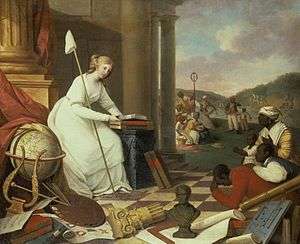Liberty Displaying the Arts and Sciences
Liberty Displaying the Arts and Sciences, or The Genius of America Encouraging the Emancipation of the Blacks (1792) is an oil-on-canvas painting by the American artist Samuel Jennings.
| Liberty Displaying the Arts and Sciences | |
|---|---|
 | |
| Artist | Samuel Jennings (artist) |
| Year | 1792 |
| Medium | Oil-on-canvas |
| Dimensions | 153 cm × 190 cm (60 1⁄4 in × 74 in) |
| Location | Library Company of Philadelphia |
The Library Company of Philadelphia, a private lending library founded by Benjamin Franklin in the mid-18th century, commissioned Jennings (an ex-Philadelphian relocated to London) to create a work depicting "the figure of Liberty (with her cap and proper Insignia) displaying the arts" as a representation of slavery and a symbol of the abolitionist movement. The library records the painting as having been given to it by the artist.
Jennings's painting shows a blond, white personification of Liberty, or according to the full title, personification of America with a liberty cap on a pike or spear presenting books (the catalog of the Library Company, and two others, labeled "philosophy" and "agriculture") to three grateful, supplicant blacks (freed slaves). Surrounding the four figures, in the foreground, are various symbols of knowledge and learning: a bust, a scroll (labeled "geometry"), papers and columns (architecture); a globe (geography), a lyre and sheet music (music), and a paper with escutcheons on it (history and heraldry). In the background, former slaves are dancing and celebrating around a liberty pole; behind them are ships on a body of water.
The work is the earliest known American painting promoting abolitionism in the United States.
References
- Nelson, Charmaine. "Hiram Powers's America: Shackles, Slaves, and the Racial Limits of Nineteenth-Century Identity." Canadian Review of American Studies. Volume 34, Number 2: 2004 (p. 167-183).
- Robert C. Smith. "Liberty Displaying the Arts and Sciences: A Philadelphia Allegory by Samuel Jennings." Winterthur Portfolio. Volume 2: 1965.